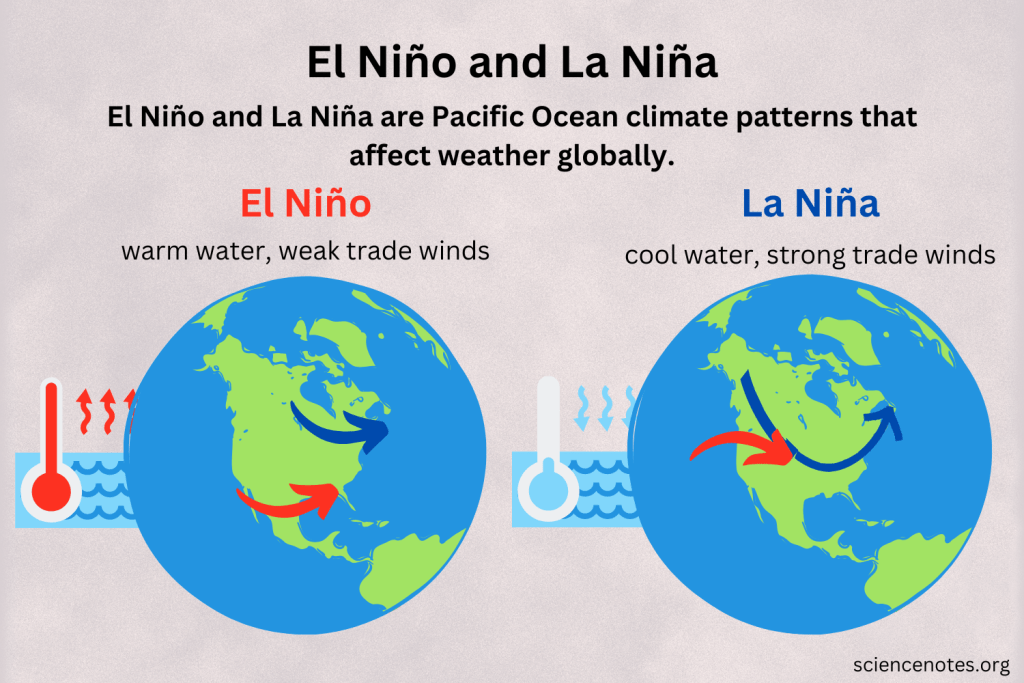Ahmedabad
(Head Office)Address : 506, 3rd EYE THREE (III), Opp. Induben Khakhrawala, Girish Cold Drink Cross Road, CG Road, Navrangpura, Ahmedabad, 380009.
Mobile : 8469231587 / 9586028957
Telephone : 079-40098991
E-mail: dics.upsc@gmail.com

EL Nino
News: As per the IMD, India is likely to see above-normal maximum and minimum temperatures in summer due to El Nino.
Background:
• IMD customarily puts out a forecast for the summer season in the first week of March every year.
• India is likely to experience a warmer start to the summer season this year with El Nino conditions predicted to continue through the season.
Ocean-atmosphere system
Normal Conditions
• During normal conditions in the Pacific Ocean, trade winds blow west along the equator, taking warm water from South America towards Asia.
• To replace that warm water, cold water rises from the depths — a process called upwelling.
• The warmer surface waters near Indonesia creates a region of low-pressure area, causing the air to rise upwards. This also results in formation of clouds and heavy rainfall. The air flow also helps in building up the monsoon system which brings rainfall over India.
Abnormal Conditions
• Both El Nino and La Nina usually begin to develop in the March to June season, reach their peak strength in the winters and then begin to dissipate in the post winter season.
• Both these phases typically last for a year, though La Nina, on an average, lasts longer than El Nino.
• While these phases alternate over a period of two to seven years, with the neutral phase thrown in between, it is possible for two consecutive episodes of El Nino or La Nina to occur.
What is El-Nino?
• El Niño means Little Boy in Spanish. It is a climate phenomenon characterized by the periodic warming of sea surface temperatures in the central and eastern equatorial Pacific Ocean.
• During El Niño, trade winds weaken. Warm water is pushed back east, toward the west coast of the Americas and as a result cold water is pushed towards Asia.
What is the impact of El-Nino?
• Ocean Temperatures: El Niño significantly affects ocean temperatures. During an El Niño event, the eastern tropical Pacific experiences warmer-than-normal sea surface temperatures.
• Ocean Currents: The speed and strength of ocean currents are influenced by El Niño. These changes can have far-reaching effects on marine ecosystems and weather patterns.
• Coastal Fisheries: El Niño impacts the health of coastal fisheries. Warmer waters can alter the distribution of fish species, affecting fishing industries.
• Local Weather: El Niño’s influence extends beyond the ocean. It affects local weather patterns across regions from Australia to South America and beyond.
• Irregular Occurrence: El Niño events occur irregularly, with intervals ranging from two to seven years. Unlike regular cycles, such as ocean tides, El Niño is not predictable in the same way.
• Water Scarcity: Decreased rainfall during El Niño events can lead to water scarcity in many parts of India. This can affect drinking water supplies, irrigation for agriculture, and hydropower generation.

Address : 506, 3rd EYE THREE (III), Opp. Induben Khakhrawala, Girish Cold Drink Cross Road, CG Road, Navrangpura, Ahmedabad, 380009.
Mobile : 8469231587 / 9586028957
Telephone : 079-40098991
E-mail: dics.upsc@gmail.com
Address: A-306, The Landmark, Urjanagar-1, Opp. Spicy Street, Kudasan – Por Road, Kudasan, Gandhinagar – 382421
Mobile : 9723832444 / 9723932444
E-mail: dics.gnagar@gmail.com
Address: 2nd Floor, 9 Shivali Society, L&T Circle, opp. Ratri Bazar, Karelibaugh, Vadodara, 390018
Mobile : 9725692037 / 9725692054
E-mail: dics.vadodara@gmail.com
Address: 403, Raj Victoria, Opp. Pal Walkway, Near Galaxy Circle, Pal, Surat-394510
Mobile : 8401031583 / 8401031587
E-mail: dics.surat@gmail.com
Address: 303,305 K 158 Complex Above Magson, Sindhubhavan Road Ahmedabad-380059
Mobile : 9974751177 / 8469231587
E-mail: dicssbr@gmail.com
Address: 57/17, 2nd Floor, Old Rajinder Nagar Market, Bada Bazaar Marg, Delhi-60
Mobile : 9104830862 / 9104830865
E-mail: dics.newdelhi@gmail.com